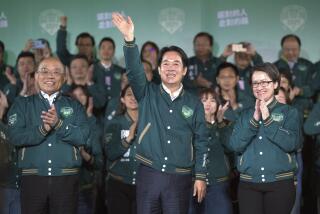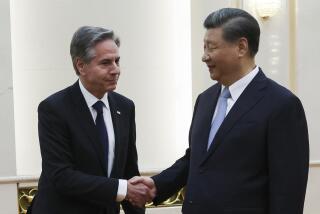China Crisis Is Battle to Shape ‘Second Revolution,’ U.S. Analysts Say
- Share via
WASHINGTON — The crisis now convulsing China, at one level just an old-fashioned power struggle among aged autocrats, is also a deep-rooted conflict over how to manage “the second Chinese revolution,” U.S. analysts believe--a confrontation between contending visions of the pace and shape of political and economic change.
For now, that struggle appears likely to result in a purge or even repression of dissent to a degree not seen for years. But American experts predicted Friday that even a massive use of military power would not end a clash of political and social forces that have built up during a decade of internal debate.
Nearly all of the country’s top leaders favor a continuation of the extraordinary process of reform that began 13 years ago with the death of Mao Tse-tung.
But China’s one-party government is split down the middle by disagreement over the breadth and speed of change, the U.S. experts said, and about how much the grip of the central government and the Communist Party should be loosened.
“This has been a continuing dispute between those who want to move quickly and those who want to go slow,” said Ralph Clough of Johns Hopkins University.
In general terms, American analysts said, advocates of more rapid change, such as party chief Zhao Ziyang, favor a much greater role for free-market mechanisms. They also want to give more local officials and others a voice in the country’s political process.
Conservatives, however, want a slower pace and retention of the central bureaucracy’s authority in political and economic matters.
Maintaining Their Share
“We tend not to see the forces for conservatism very well,” noted Thomas Bernstein of Columbia University. “But there are a good many forces in China who want to preserve a more orthodox Marxist-Leninist system. They want to maintain their share of the pie.”
The ruthless quality of the conservatives’ effort to quash the pro-democracy movement was provoked by the overwhelming size and fervor of the demonstrations that have swept Beijing in recent weeks--offering as they did a remarkable vision of just how strong the popular appetite for change had become.
As American specialists assess the situation, the outpouring provided an unexpected opportunity for Zhao and others who have advocated an accelerated pace of reform. At the same time, it provided an unprecedented threat to Premier Li Peng and others determined to maintain tight government control over popular expression. The result was a leadership struggle of extraordinary ferocity.
That Li now appears to have gained tighter control--and reportedly to have charged his enemies with anti-party activity--represents a decisive triumph for the forces of caution.
More Fundamental Clash
But some U.S. experts predict that it may set in motion an even more fundamental clash, as the millions of Chinese burdened by economic troubles and political repressiveness become more assertive in their calls for rapid change.
“These may be backward steps for the reformers,” said Anthony Kane, director of the Asia Society’s council on China. “But I think what you’ve found in this process is an awakening of consciousness, and I don’t think you’re going to find that fading away.”
Even the scholars who watch China most closely cannot offer detailed blueprints outlining the contending visions of that country’s future. Detailed plans may not exist even in the minds of China’s leaders; when senior leader Deng Xiaoping has talked of political reform, for example, he has never specified exactly what he meant.
It is clear in general terms, however, that radical reformers such as Zhao favor a much greater role for market forces.
In the political realm, specialists say, the radical reformers advocate extensive pluralization, granting greater freedom to the press and enlarging the roles of state and local legislatures as counterweights to the central government. And as the Brookings Institution’s Harry Harding argues, the Zhao faction has tended to be “bold and enthusiastic” about reform, while their antagonists have tended to be “cautious and skeptical.”
The banner-carrying demonstrators in the streets of Beijing this month included a coalition whose membership extended far beyond the usual embittered intellectuals and students crusading for democracy, specialists note.
This time, there were factory workers, teachers and even civil servants linked not so much by concern about the slow pace of political reform but about its economic consequences: inflation, corruption and privileges for the elite. If the political process could be opened up, some argued, the economic toll might not be so great.
Such unified exhortation presented the opportunity that exhilarated the radicals and provoked the conservative Li Peng forces into the declaration of martial law and the expected purge of Zhao and his allies, U.S. specialists say.
The crackdown represents the defensive response of an autocratic leadership under fire from its people. But resistance to cries for reform also served the wishes of a less vocal sector of the Chinese population--the military, bureaucrats and provincial officials whose interests are best served by the current system, the experts say.
U.S. analysts expressed little surprise that the conservative forces again appear ascendant, noting the tenacity that political leaders generally exhibit when their power is threatened.
What was most notable, they said, was tentative evidence that Li and his allies have determined to strike back at their opponents with tactics--house arrest, accusations of crimes against the party, and perhaps the use of force--that have not been seen in China since the Cultural Revolution.
“When you get to the point where principled disagreements are looked on as treason,” said Kane of the Asia society, “then you’ve got a very destructive political process.”
More to Read
Sign up for Essential California
The most important California stories and recommendations in your inbox every morning.
You may occasionally receive promotional content from the Los Angeles Times.













